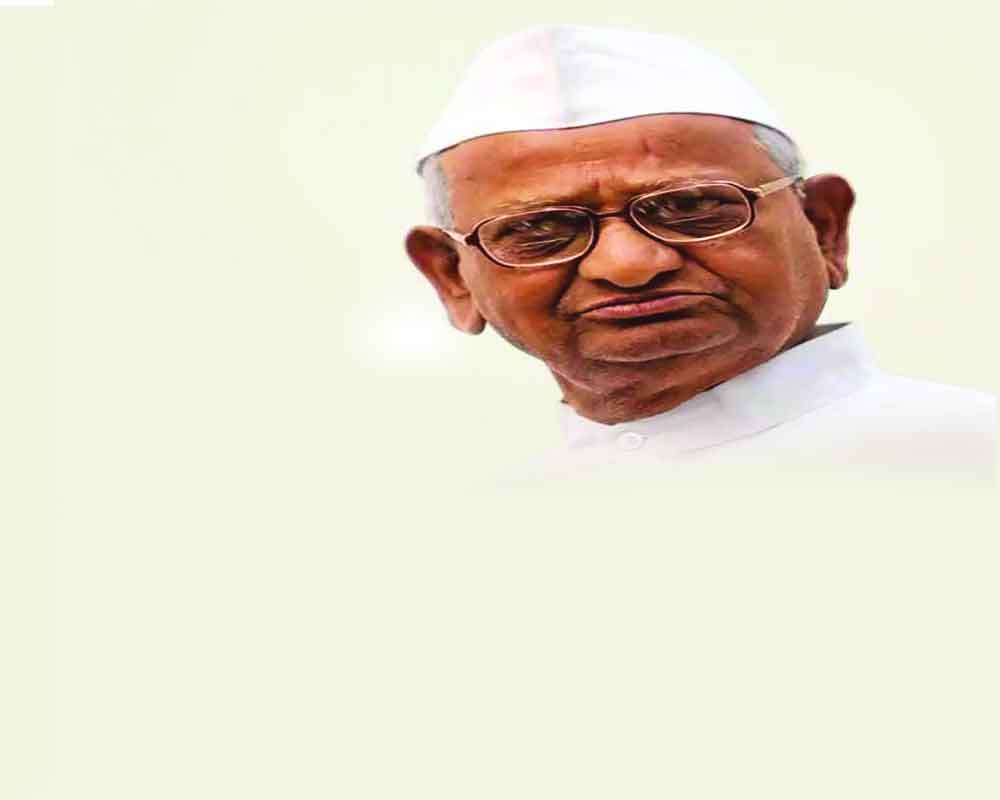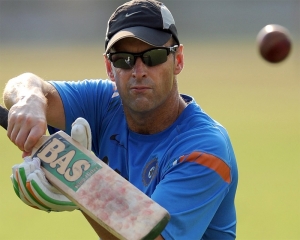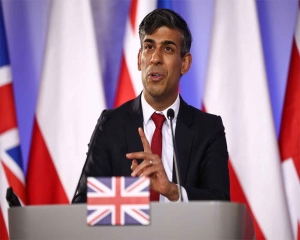SIDHARTH MISHRA delves into the ideological moorings of the Anna Hazare movement and what change, if any, this agitation brought to our social system. It is difficult to find an answer
Come April, come the anniversary of the agitation which was expected to prove to be a game changer in Indian politics, however, as American poet TS Eliot would put it, ‘went down with a whimper.’ It all began with the Anti-Corruption Movement launched by Anna Hazare in 2011, and whatever was left of its ideals have been given a firm burial with the arrest of movement’s mainstay Arvind Kejriwal.
First at Jantar Mantar in April and thereafter in August, 2011 dawned on historical Ramlila Grounds in Delhi a social reformer from Maharashtra, Kisan Baburao Hazare. He was at the helm of an anti-corruption movement against the Congress governments both at the Centre and in the state.
Popular as Anna among his followers, Hazare, a former army truck driver, dressed like an Indian farmer-dhoti (a wrapper), kurta (a tunic) and a cap, popularly called Gandhi Topi (cap), all made in handspun fabric of Khadi. In Anna people saw, though briefly, a reincarnation of Gandhi, and no wonder in effort to identify themselves with Anna they started to wear the Gandhi like cap with these words printed on it “Main Hun Anna” (I am Anna).
People who joined the agitation wearing Anna Caps were later to realize that the movement was Gandhian neither in letter nor in spirit but did thrive on Gandhian imageries. The identification with Gandhi, as the events which later unfolded showed, was superficial. This was a successful exercise in the branding of the movement by its clever brand managers led by now incarcerated chief minister of Delhi Arvind Kejriwal.
While Gandhi insisted that his followers wore caps made from handspun fabric, Anna’s followers wore caps from an environmentally degrading synthetic material. The environmentalist in Gandhi would have never approved of use of synthetic material for sewing caps, as he would have not approved of the turn this movement took..
Media Event Sold Gandhian Movement
Use of Gandhian caps was not the only instance of misuse of the Gandhian image during the Anna Hazare Movement. During the agitation in April 2011 at Jantar Mantar, the highest circulated newspaper of the nation-The Times of India-carried the headline: “INDIA WINS AGAIN.” If culmination of every successful media event was to make India win, yes, the headline was appropriate. But would the newspaper recall its headline now 13 years later, after the arrest of movement’s architect Arvind Kejriwal.
One is still to know what was the ideological basis of this movement? The leaders from the movement have gone different ideological ways. What change it brought other than blowing our Constitution to the smithereens and setting up another political party?
In this era of publicity, anonymity is tyag (abnegation), a certain Gandhian ideal. Wearing a Gandhi cap and a khadi dhoti-kurta alone doesn’t make one a Gandhian. In what he wore, Mahendra Singh Tikait, the Kisan leader from Muzzafarnagar in Uttar Pradesh was as much a Gandhian as Anna Hazare of Ahmednagar in Maharashtra. In fact, Gandhi decided to wear the cap in the early part of his career to identify with the Indian peasantry, who he rightly realised was integral to the success of the people’s movement.
Hazare was un-Gandhian as far as his leadership of India Against Corruption movement went. The Civil Society, which played the role of catalyst during the movement, largely connotes the creamy layer of our social system with little connect to our social and cultural dynamics.
Unlike Anna, Gandhi’s movement was not captive to certain self-acclaimed representatives of the people. The representation was based on a detail electoral process ensuring a true representation of the people in the decision-making process. The AAP grounded the internal democracy in the party a few years after its founding establishing Arvind Kejriwal as its dictator. Anna Hazare too was no different in his world view.
If one looks for comparisons for Anna Hazare’s agitation, one can find only one-the public outcry in 1999 against the hijacking of the Indian Airlines IC-814 flight from Kathmandu to Delhi to the Taliban land of Kandhar. The television cameras then too had gone to town over people agitating against “the Government’s failure to save the lives of its citizens.” It brought such pressure on our Government that we had to release the terror vendors, who had been arrested following martyrdom of several Indian soldiers. Till date, the nation is paying a heavy price for releasing the likes of Azhar Masood, who later founded Jaish-i-Mohammed to secure the release of citizens held hostage.
An evil plaguing the television media is that in their craving for TRPs they rush to ferret out the imitation as the real. They seldom make an effort to go beyond the superficial. In my initial years as journalist, my first chief reporter would always take me to the task for having an opinion. “Report news, write comments when you have a column to yourself,” he would thunder.
In 1999, when the television media cried hoarse on the demand by the citizens to secure release of the hostages of IC-814, little did it realize that it was the Opposition Congress, in a bid to embarrass the Government, which was surreptitiously instigating people? The leader of the agitation was one Shreeram Maggo, a Congress worker from West Delhi. For his services, he was later bequeathed with a ticket to contest the Assembly polls and still later his daughter-in-law became member of the Municipal Council of Delhi on a Congress ticket.
In a just case of poetic justice, the Congress-led Government in 2011 suffered at the hands of the same media. The Congress claim of the Opposition elements adding fuel to the Jantar Mantar fire went uncontested as then non-Congress Chief Ministers Narendra Modi and Nitish Kumar openly supported the movement. The Rashtriya Swayamsewak Sangh (RSS) too released a statement in the support of the cause. There was open sloganeering against Sonia Gandhi’s foreign origin and Manmohan Singh being of not much consequence than a family butler.
Non-Gandhian Venue for Protest
Another point of difference between Gandhi’s and Anna’s movements was venue of the protest. Gandhi never chose New Delhi as the site for any of his major Satyagraha Movements. New Delhi is best remembered as the site of his assassination. The studio hunters of national Capital would do well to travel to Motihari, where Gandhi launched the Champaran Satyagraha a century ago. Even in this age, a television OB van would find difficult to easily reach Motihari. A century ago Gandhi went there to launch movement to be with the people and not the Press reporters.
Talking of the Press, Gandhi seldom took criticism negatively. Mahatma recounts in My Experiments with Truth an interesting appointment with the editor of The Pioneer, then considered an opponent of Indian aspirations, at Allahabad: “He promised to notice in his paper anything that I might write but added that he could not promise to endorse all the Indian demands, inasmuch as he was bound to understand and give due weight to the viewpoint of the Colonials as well. It was enough that he should study the question and discuss it in his paper.”
Unlike the Mahatma, the Anna Gandhians took to lobbying, threat and blackmail to silence voices of criticism. Attempts by probing reporters to question the protagonists of the movement were stonewalled with replies, “What’s the point talking to you people, you are against us.”
Mahatma never took decisions in a hurry and never really craved for the crowd and media support when he decided to launch a movement in sustenance of a cause. He in fact walked an extra mile to convince those holding adverse opinion in media and never indulged in McCarthyism as in the case of the pretenders to the Mahatma’s legacy.
The similarity between Hazare’s agitation and Gandhi’s movement ended with the images that the organisers tried to create pushing a clueless girl child to offer juice to Anna to end his fast, to recreate the famous image of a young Indira Gandhi offering juice to Mahatma to end his fast in 1924.
When the fast by Anna Hazare at Ramlila Maidan ended in August 2011, in a speech, Hazare sermonised on the virtues that every participant of his movement should follow. None followed including its leaders, four of whom are now in jail on corruption charges.
Difference in Approach
Having discussed matters material, I would once again come back to the question of the ideological moorings of this agitation. What change this agitation brought to our social system? It’s difficult to find an answer. If it failed to bring social change, is it correct to even call Anna’s agitation a public movement, let alone a Gandhian movement.
Hazare wore Gandhi cap, increasingly acquired Mahatma’s mannerism (as seen in Richard Attenborough’s magnum opus) and resorted to some bhajan listening. But unlike the Mahatma, he tore constitutionalism to shreds at the outset. He, through his interlocutors led by Arvind Kejriwal, Prashant Bhushan and Yogender Yadav, held out a threat to the Government at every step of negotiation. Those who reached out to cheer him realised little that in action Hazare was actually eroding the authority of Parliament, something which suited a highly discredited Manmohan Singh Government.
It created a committee to draft the Lokpal Bill, denying the Opposition benches the right to debate the provisions of the Bill. The Government then thought that to get the Bill passed, the treasury benches could conveniently deploy the Movement Against Corruption to have its own way. Hazare in a way usurped the space of legitimate Opposition. Gandhi for sure would have never advised to lose faith in our Constitutional mechanism.
During their agitation in Ramlila Ground in August 2011 I vividly recall a placard carrying photos of Anna Hazare, Kiran Bedi, Arvind Kejriwal and Prashant Bhushan calling them present day Mahatma Gandhi, Bhagat Singh, Lakshmi Bai and Chandrashekhar Azad respectively. This placard made it abundantly clear that the movement orchestrated by Team Anna did not have a cohesive ideological base. Forget their inspirations even in their practice, the members of the core committee showed very divergent personal worldviews. The only point, on hindsight, which seems to have brought them together was the desire to destabilize the government.
They together with the Government representatives-Pranab Mukherjee, P Chidambaram, Kapil Sibal, Salman Khursheed and Veerappa Moily-were initially tasked to give us the Lokpal Bill, which was to act as panacea to all ills related to corruption. One recalls Hazare having rebuffed a media query on how the Opposition was kept out of the law-making process. He said and probably believed also that the Opposition mattered little.
Less than six months later, his Team was wooing the Opposition to rescue them, when Government decided a go-slow on the Bill. More shamelessly members of his team went to Hisar in Haryana campaigning against the Congress and nearly facilitating victory of a tainted and charge-sheeted Ajay Chautala in the assembly bypolls.
Earlier in April, when the father of Ajay Chautala, former Haryana Chief Minister Om Prakash Chautala had come to pledge support to Hazare at Jantar Mantar, he was shooed away. How quick the change of heart and colour! A quality which the Mahatma never possessed.
(THE WRITER IS AN AUTHOR AND PRESIDENT CENTRE FOR REFORMS, DEVELOPMENTS AND JUSTICE)


























